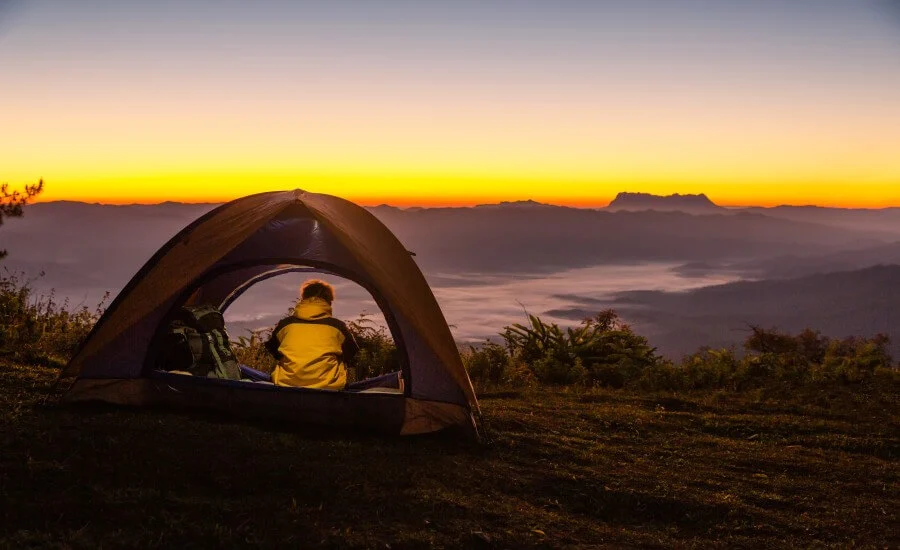
Imagine this: Dusk paints the sky in strokes of orange and purple as you finish setting up your small, solitary tent. There’s no hum of generators, no glow from neighbouring RVs, just the sigh of the wind through the trees or the vast silence of an open moor. Your phone shows ‘No Service’, and instead of anxiety, a wave of quiet relief washes over you. This is the essence of wild camping – stepping away from designated campsites, carrying everything you need on your back, and immersing yourself completely in nature, free from the digital tether.
In our hyper-connected world, the idea of intentionally choosing a spot without Wi-Fi, power outlets, or even basic facilities might seem daunting. But wild camping offers a unique opportunity for profound connection – with nature, with yourself, and with a simpler way of being. This guide is your starting point for Best Wild Camping Guide: Embracing Nature Without Wi-Fi. We’ll explore the basics of finding spots responsibly, essential gear and skills, the crucial ethics of Leave No Trace, and the deep rewards of trading screen time for starlight.
Discover Wild Camping: No Wi-Fi, More Adventure
Wild camping, at its heart, means camping outside of established, designated campsites. It’s about finding a temporary spot in the wilderness – be it mountains, forests, moors, or coastlines – relying entirely on your own resources and leaving absolutely no trace of your presence when you leave. It contrasts sharply with campsite camping (with facilities like toilets, showers, designated pitches) or car camping where your vehicle is nearby.
Key characteristics include:
- Self-Sufficiency: You carry everything you need – shelter, sleeping gear, food, water (or means to purify it), navigation tools.
- Remoteness (Often): While not always extreme, wild camping typically involves being away from roads, buildings, and amenities.
- No Facilities: Expect no toilets, running water, picnic tables, or Wi-Fi hotspots.
- Temporary & Discreet: It’s about overnight stays, typically arriving late and leaving early, choosing spots out of sight.
- Leave No Trace Ethos: This is non-negotiable (more on this later).
But why intentionally seek out places without Wi-Fi or even a phone signal? In today’s world, choosing to disconnect is a radical act. Wild camping provides the perfect context:
- Forced Digital Detox: It removes the temptation (and often the ability) to constantly check emails, scroll social media, or consume online content.
- Deep Nature Immersion: Without digital distractions, your senses open up to the environment – the sounds, smells, sights, and feel of the wild.
- Enhanced Self-Reliance: Navigating, setting up camp, sourcing water, and managing without external digital help builds confidence and practical skills.
- Mental Space: The absence of constant pings and information overload allows the mind to quieten, fostering clarity, creativity, and introspection.
Wild camping isn’t just about finding a free place to sleep; it’s often a conscious choice to embrace simplicity, self-reliance, and an unfiltered connection with the natural world, made possible by leaving the digital noise behind.
Discover Off-Grid Nature Immersion: Why Wild Camping Can Boost Your Well-Being?

Choosing to spend time wild camping, intentionally offline, unlocks a unique set of benefits that go far beyond just enjoying scenery. It’s a powerful antidote to the stresses and distractions of modern life.
- Deepened Nature Connection: Without screens vying for your attention, you become acutely aware of the environment. You notice the changing light, the calls of birds, the tracks of animals, the direction of the wind. This fosters a profound sense of belonging and connection to the natural world.
- Mental Clarity & Stress Reduction: Stepping away from the relentless influx of information and notifications allows your mind to genuinely rest and reset. The simplicity of the tasks at hand (shelter, water, food) focuses the mind, reducing anxiety and mental clutter. Nature itself is proven to have restorative effects on mental well-being.
- Enhanced Self-Reliance & Confidence: Successfully navigating, setting up camp, managing resources, and spending a night alone (or with minimal company) in the wild builds significant self-confidence and practical skills. You learn to trust your judgment and capabilities.
- Improved Sleep Quality: Aligning your sleep patterns with the natural light cycle (rising with the sun, resting after dark) and escaping the blue light of screens can dramatically improve sleep quality. The sounds of nature often provide a soothing backdrop.
- Appreciation for Simplicity: Making do with only what you carry fosters a deep appreciation for simple comforts – a warm drink, a dry shelter, a beautiful view. It can help reset perspectives on material needs versus genuine well-being.
- True Solitude & Peace: Wild camping offers the increasingly rare opportunity for genuine solitude and quiet, allowing for introspection, reflection, or simply being without external demands.
The experience of being truly self-sufficient and disconnected, immersed in nature, is a powerful reminder of our innate resilience and our fundamental connection to the wild. It’s a recharge that goes deeper than simply resting at home. What aspect of being unplugged in nature appeals most to you?
Finding Your Spot: Legality, Respect and Location Tips

This is arguably the most critical aspect of responsible wild camping. Unlike designated campsites, you can’t just pitch your tent anywhere. Legality and responsible site selection are paramount to protect fragile environments and maintain access rights where they exist.
The Golden Rule: Check Local Regulations FIRST!
- Legality Varies Massively: Wild camping laws differ drastically from country to country, and even region to region within countries.
- Examples: It’s generally legal and accepted under specific codes in Scotland and parts of Scandinavia (Right to Roam/Allemansrätten). It’s largely illegal without landowner permission in England and Wales. In the USA, it’s often permitted in National Forests and BLM land under dispersed camping rules (away from roads/water), but strictly prohibited in most National Parks outside designated backcountry sites.
- India Context: Wild camping in India is generally restricted or illegal in National Parks, Wildlife Sanctuaries, and Reserved Forests without specific, hard-to-obtain permits. Local customs and land ownership are complex. Never assume you can camp anywhere. Always seek current, official information from local authorities (Forest Department, local administration) or experienced local guides/organizations before even considering it. Err on the side of caution – if in doubt, don’t camp.
- Permission is Key: On private land anywhere, you always need explicit permission from the landowner beforehand.
- Public Land Rules: Even where permitted on public land, there are usually rules (distance from roads/water/trails, group size limits, duration limits, fire restrictions).
Choosing a Responsible Location
Once you’ve confirmed legality, selecting where to pitch involves respecting the environment:
- Arrive Late, Leave Early: Minimize your visual impact and time spent in one spot.
- Camp on Durable Surfaces: Use established spots if they exist (showing minimal impact). Otherwise, choose robust ground like dry grass, sand, or gravel. Avoid fragile vegetation, mosses, or areas showing signs of erosion.
- Stay Away from Water: Camp at least 60-70 meters (about 200 feet or 70 big steps) away from lakes, rivers, and streams to protect water quality and allow wildlife access.
- Be Discreet: Camp out of sight of trails, roads, and buildings. Keep noise levels minimal. Choose muted tent colors if possible.
- Small Groups: Wild camping is best suited for individuals or very small groups to minimize impact.
- Check for Hazards: Avoid camping directly under large dead branches (widowmakers), in dry riverbeds prone to flash floods, or in obvious animal trails.
Responsible site selection is fundamental. It ensures your enjoyment doesn’t come at the cost of environmental damage or conflict with landowners or regulations. Always prioritize legality and minimal impact.
Best Wild Camping Tips: Essential Guide to Wild Camping Without Internet

Successfully and safely enjoying a wild camp, especially while disconnected, requires some basic skills and preparation. This isn’t about complex survivalism, but practical self-sufficiency. This section covers the essentials for Wild Camping 101: Embracing Nature Without Wi-Fi.
Navigation Essentials (Beyond GPS)
Relying solely on a phone GPS in remote areas without signal is risky.
- Map & Compass: Learn basic map reading (understanding contour lines, symbols, scale) and how to use a compass (orienting the map, taking bearings). Practice these skills in familiar areas first. A physical map is reliable regardless of battery life or signal.
- Offline Map Apps (as Backup/Planning): Apps like Gaia GPS, OS Maps (UK), Maps.me, or Organic Maps allow you to download detailed topographic maps for offline use. Use them for planning and as a backup, but don’t rely on them exclusively. Carry a power bank if using a phone for navigation.
- Natural Navigation/Awareness: Pay attention to the landscape, sun position, prevailing wind, and landmarks as you walk. This builds situational awareness.
Water Sources & Treatment
You’ll likely need to source water from streams, rivers, or lakes.
- Identify Sources: Look for clear, flowing water sources on your map and scout them out. Avoid stagnant water or water downstream from heavy agricultural/industrial areas.
- ALWAYS Treat Water: Never assume natural water is safe to drink. It can contain bacteria, viruses, or protozoa. Always filter (using a reputable backpacking filter like Sawyer Squeeze, Katadyn BeFree) and/or purify (using chemical tablets/drops or a UV sterilizer) water before drinking or cooking with it. Boiling is also effective but uses fuel.
Basic Camp Setup & Safety
- Shelter: Practice pitching your tent/tarp quickly and securely, especially in potentially windy or rainy conditions. Know how to choose a good pitch spot (level, sheltered if possible, good drainage).
- Camp Kitchen: Learn to use your backpacking stove safely and efficiently. Plan simple, energy-dense meals. Store food properly to avoid attracting wildlife (see LNT).
- Weather Awareness: Check forecasts before leaving and be prepared for changes. Understand risks like hypothermia (dress in layers, stay dry) and heat exhaustion (hydrate, seek shade).
- Basic First Aid: Carry a well-stocked first-aid kit and know how to treat common issues like blisters, cuts, sprains, and insect bites. Consider a basic first-aid course.
- Wildlife Precautions: Be aware of local wildlife. Store food and scented items securely (often hung in a tree away from camp or in bear canisters in relevant areas). Never feed wildlife. Make noise occasionally while hiking in bear country.
Mastering these basics ensures you can handle common situations safely and comfortably, allowing you to relax and enjoy the unplugged experience.
Leave No Trace: The Wild Camper’s Essential Code

This is the ethical foundation of wild camping. Leaving no trace means ensuring that your presence has the minimum possible impact, leaving the environment just as pristine—or even better—than you found it. Adhering to the Leave No Trace (LNT) principles is crucial for protecting wild places and maintaining access.
The Seven Principles, adapted for wild camping:
-
Plan Ahead and Prepare:
- Know the regulations and special concerns for the area you’ll visit.
- Prepare for extreme weather, hazards, and emergencies.
- Schedule your trip to avoid times of high use.
- Visit in small groups.
- Repackage food to minimize waste.
- Use a map and compass to eliminate the use of marking paint, rock cairns or flagging.
-
Travel and Camp on Durable Surfaces:
- Durable surfaces include established trails and campsites, rock, gravel, dry grasses or snow.
- Protect riparian areas by camping at least 200 feet (70 adult steps) from lakes and streams.
- Good campsites are found, not made. Altering a site is not necessary.
- In popular areas: Concentrate use on existing trails and campsites. Walk single file in the middle of the trail, even when wet or muddy. Keep campsites small. Focus activity in areas where vegetation is absent.
- In pristine areas: Disperse use to prevent the creation of campsites and trails. Avoid places where impacts are just beginning.
-
Dispose of Waste Properly:
- Pack it in, pack it out. Inspect your campsite and rest areas for trash or spilled foods. Pack out all trash, leftover food, and litter – including biodegradable items like fruit peels.
- Human Waste: Deposit solid human waste in catholes dug 6 to 8 inches deep, at least 200 feet from water, camp, and trails. Cover and disguise the cathole when finished. Pack out toilet paper and hygiene products. (Urine has less impact but avoid urinating directly on vegetation). In some sensitive/high-use areas, packing out human waste in specialized bags may be required.
- Wastewater: To wash yourself or your dishes, carry water 200 feet away from streams or lakes and use small amounts of biodegradable soap. Scatter strained dishwater.
-
Leave What You Find:
- Preserve the past: Examine, but do not touch, cultural or historic structures and artifacts.
- Leave rocks, plants and other natural objects as you find them.
- Avoid introducing or transporting non-native species.
- Do not build structures, furniture, or dig trenches.
-
Minimize Campfire Impacts:
- Campfires can cause lasting impacts. Use a lightweight stove for cooking and enjoy a candle lantern for light. Stoves are preferable, cleaner, and often safer.
- Where fires are permitted (check local regulations – often prohibited), use established fire rings, fire pans, or mound fires.
- Keep fires small. Only use sticks from the ground that can be broken by hand.
- Burn all wood and coals to ash, put out campfires completely, then scatter cool ashes. Never leave a fire unattended.
-
Respect Wildlife:
- Observe wildlife from a distance. Do not follow or approach them.
- Never feed animals. Feeding wildlife damages their health, alters natural behaviors, and exposes them to predators and other dangers.
- Protect wildlife and your food by storing rations and trash securely.
- Control pets at all times, or leave them at home.
- Avoid wildlife during sensitive times: mating, nesting, raising young, or winter.
-
Be Considerate of Other Visitors:
- Respect other visitors and protect the quality of their experience.
- Be courteous. Yield to other users on the trail.
- Take breaks and camp away from trails and other visitors.
- Let nature’s sounds prevail. Avoid loud voices and noises.
Following LNT isn’t optional; it’s the responsibility that comes with the privilege of experiencing wild places.
Essential Gear for Off-grid Adventures

Wild camping requires carrying everything you need for safety and comfort. While gear lists vary by trip length, climate, and personal preference, here are the core essentials for an unplugged overnight trip:
- Shelter: Tent, Tarp, or Bivy Sack (appropriate for expected weather).
- Sleeping System: Sleeping Bag (rated for expected temperatures), Sleeping Pad (insulation & comfort).
- Backpack: Comfortable pack large enough to carry all gear (typically 40-65 liters).
- Navigation: Map (physical, waterproofed), Compass, (Optional but Recommended Backup: GPS device or phone with offline maps & power bank).
- Water: Water bottles or bladder (capacity for planned route), Water Filter or Purification System (tablets, UV).
- Cooking: Backpacking Stove, Fuel, Lighter/Matches, Pot, Eating Utensil, Mug.
- Food: Lightweight, non-perishable, high-energy food for planned meals + extra emergency rations.
- Clothing:
- Layers (base layer, mid-layer fleece/puffy, waterproof/windproof outer shell).
- Extra socks.
- Hat & gloves (even in summer at altitude).
- Sun hat.
- Illumination: Headlamp or flashlight with extra batteries.
- First-Aid Kit: Comprehensive kit tailored to potential risks, including blister care, pain relief, bandages, antiseptic wipes. Know how to use it.
- Sun Protection: Sunscreen, sunglasses.
- Hygiene: Trowel (for catholes), toilet paper (pack out used), hand sanitizer, basic toiletries (toothbrush, travel-size toothpaste).
- Repair Kit: Duct tape, safety pins, small knife/multi-tool, tent pole sleeve (optional).
- Waste Bags: To pack out all trash, including toilet paper. Ziploc bags work well.
- (Optional) Emergency Communication: Personal Locator Beacon (PLB) or Satellite Messenger (like Garmin inReach) – crucial for remote areas with no cell signal, even if aiming for digital detox.
Focus on gear that is reliable, lightweight, and functional. Practice using your gear before your first wild camping trip.
Common Concerns & Solutions for Aspiring Wild Campers

Stepping into the wild self-sufficiently can feel intimidating. Here are common beginner concerns:
- Concern: “Is it safe? What about wildlife or getting lost or camping alone?”
- Solution: Mitigate risks through preparation. Learn navigation skills thoroughly. Check weather forecasts. Inform someone reliable of your exact route and expected return time. Carry appropriate safety gear (first aid, emergency communication). Learn about local wildlife and take precautions (food storage). Start in familiar areas or go with experienced friends initially. Solo wild camping requires building confidence gradually.
- Concern: “How do I really find legal and suitable spots?”
- Solution: Diligent research is key. Use official sources (park websites, government land agencies, local authority websites) to understand rules. Study maps (topographic maps show terrain, water sources, potential flat areas away from trails). Scout potential areas beforehand if possible. Be prepared to walk further than planned to find a suitable, responsible spot. When in doubt, don’t camp there.
- Concern: “I’ll be bored without my phone/internet/entertainment!”
- Solution: Embrace the quiet. See it as an opportunity, not a deprivation. Bring a physical book or a small journal. Focus on simple camp tasks, observing nature, stargazing, or simply resting. The initial restlessness often gives way to a deeper sense of peace and engagement with the surroundings.
- Concern: “What about hygiene and going to the toilet?”
- Solution: Practice LNT principles. Use a trowel to dig proper catholes for solid waste far from water sources. Pack out all toilet paper. Use hand sanitizer. Basic hygiene (like brushing teeth) can be maintained using minimal water carried away from sources. It’s about basic function, not spa-level cleanliness.
Start small, build skills progressively, prioritize safety and LNT, and embrace the learning process.
Finding Freedom in Simplicity and Stillness

Wild camping without the constant companion of Wi-Fi is more than just sleeping outdoors; it’s an intentional act of reclaiming simplicity, fostering self-reliance, and forging a deeper connection with the natural world. It’s about discovering the profound peace that arises when the digital noise fades and the subtle symphony of nature takes center stage. The challenge of navigating by map and compass, sourcing water, and creating shelter with your own hands builds a quiet confidence that echoes long after you’ve packed up your tent.
The freedom found in wild camping is balanced by a critical responsibility – the unwavering commitment to Leave No Trace. Protecting these wild places ensures they remain vibrant and accessible for future generations and wildlife. Respecting local regulations and landowner rights is equally paramount.
If the call of the wild whispers to you, encouraging you to step away from the screen and into the elements, start thoughtfully. Begin with research, practice essential skills close to home, invest in reliable basic gear, and always prioritize safety and ethical principles. The rewards – clarity, connection, resilience, and the simple joy of waking up immersed in nature – are well worth the effort. Unplug, step out, and discover the world waiting beyond the Wi-Fi signal.




